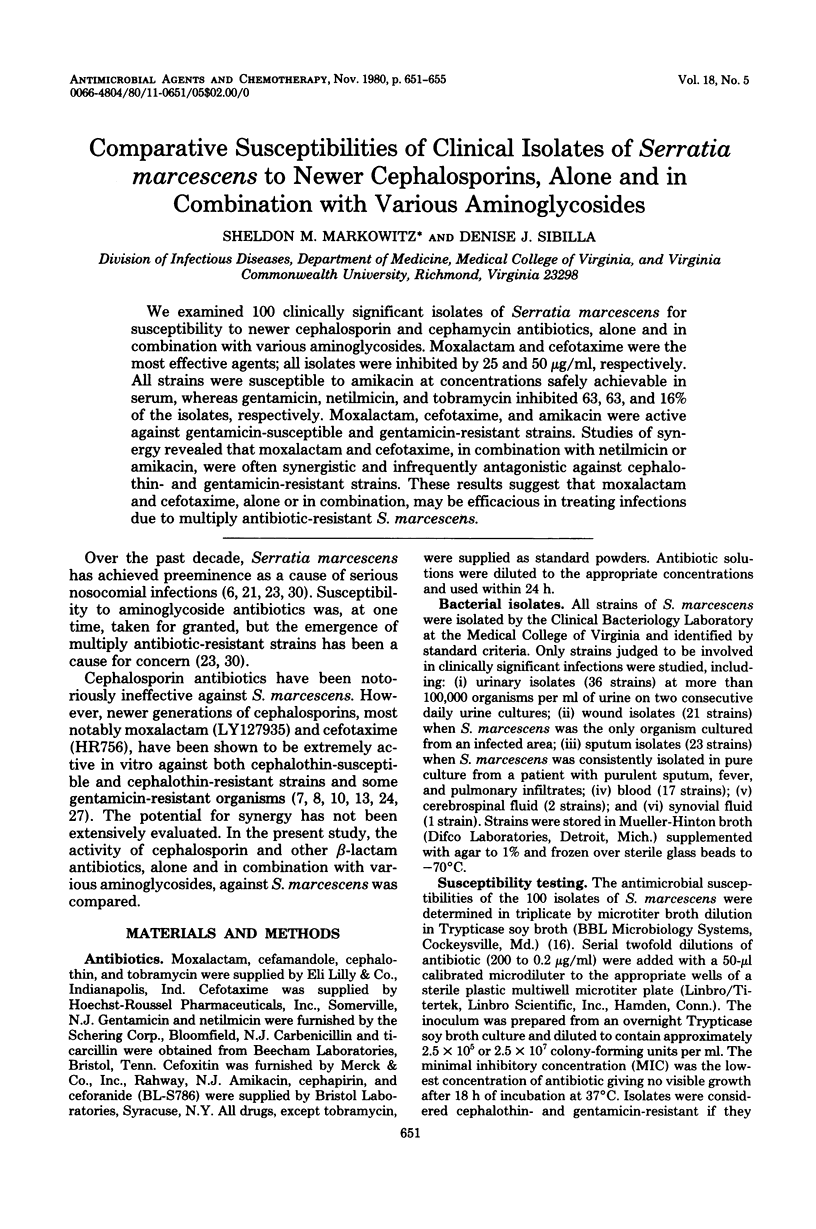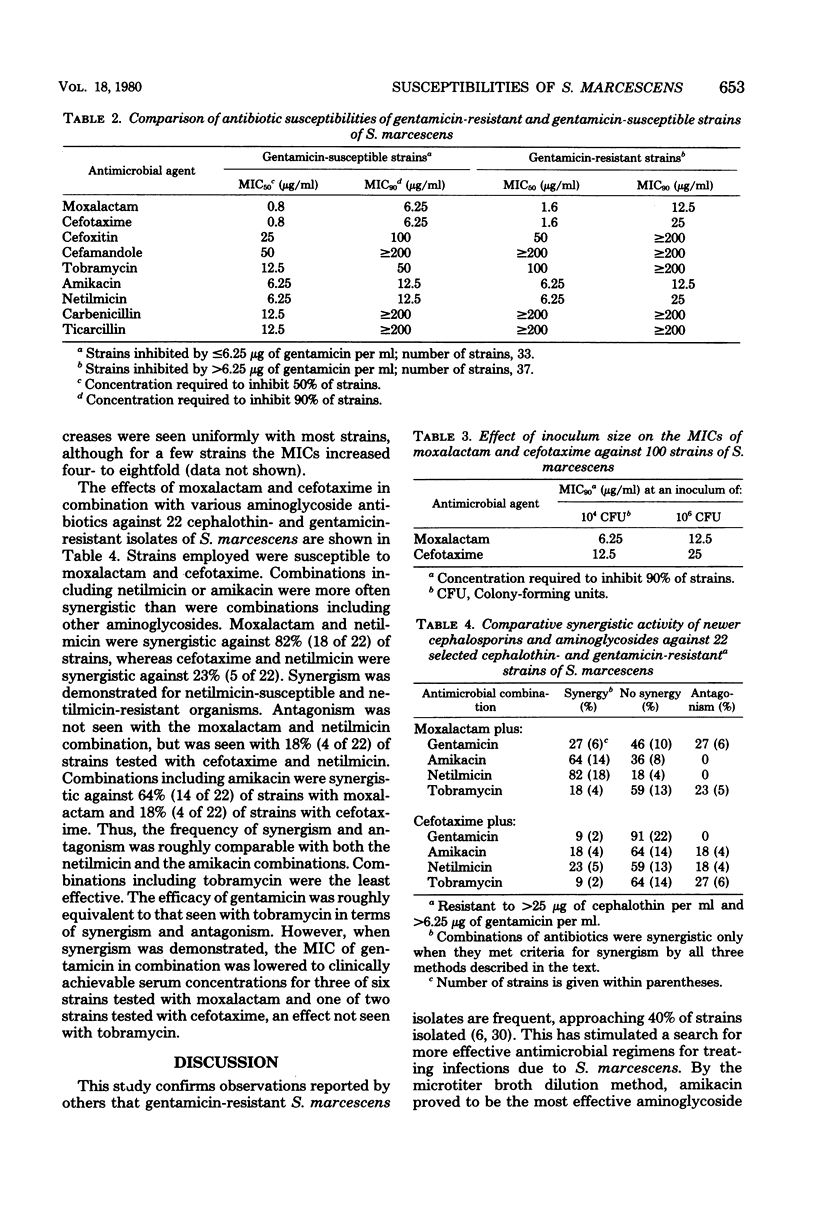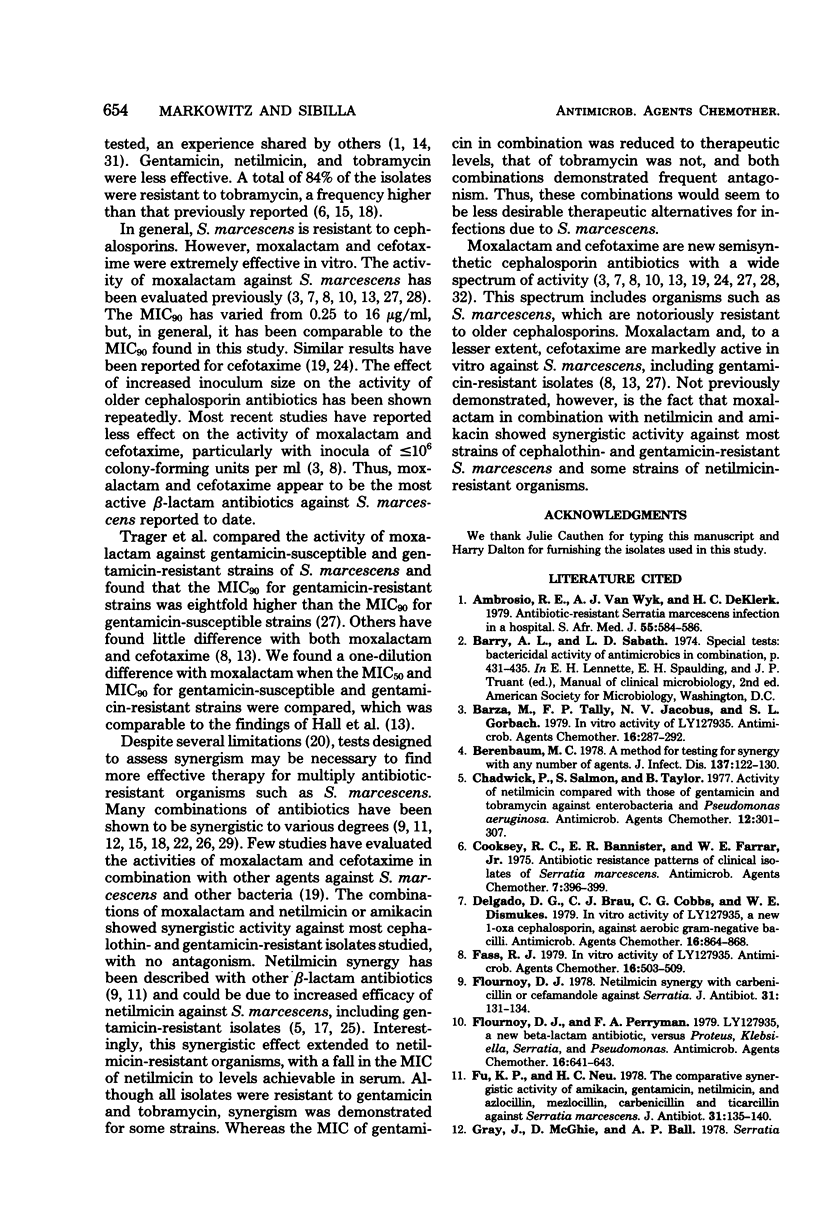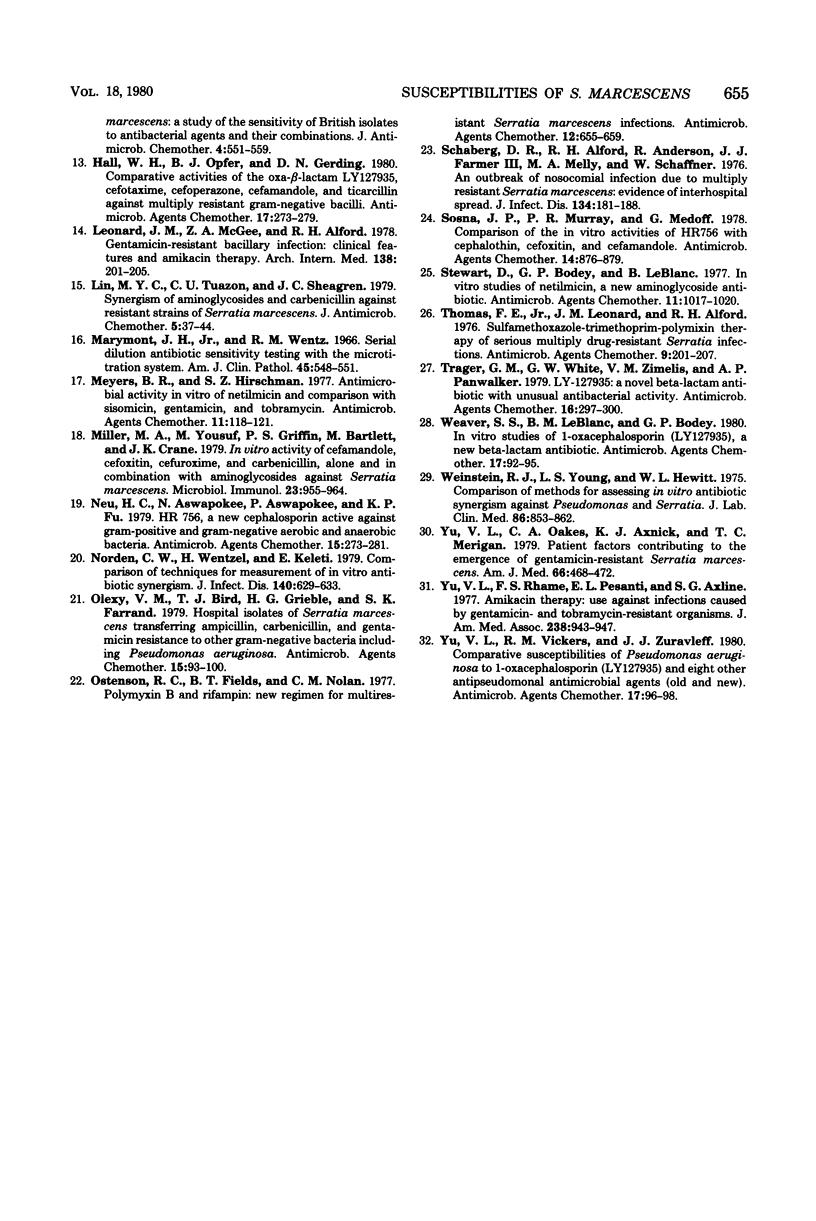Abstract
We examined 100 clinically significant isolates of Serratia marcescens for susceptibility to newer cephalosporin and cephamycin antibiotics, alone and in combination with various aminoglycosides. Moxalactam and cefotaxime were the most effective agents; all isolates were inhibited by 25 and 50 micrograms/ml, respectively. All strains were susceptible to amikacin at concentrations safely achievable in serum, whereas gentamicin, netilmicin, and tobramycin inhibited 63, 63, and 16% of the isolates, respectively. Moxalactam, cefotaxime, and amikacin were active against gentamicin-susceptible and gentamicin-resistant strains. Studies of synergy revealed that moxalactam and cefotaxime, in combination with netilmicin or amikacin, were often synergistic and infrequently antagonistic against cephalothin- and gentamicin-resistant strains. These results suggest that moxalactam and cefotaxime, alone or in combination, may be efficacious in treating infections due to multiply antibiotic-resistant S. marcescens.
Full text
PDF




Selected References
These references are in PubMed. This may not be the complete list of references from this article.
- Ambrosio R. E., Van Wyk A. J., De Klerk H. C. Antibiotic-resistant Serratia marcescens infection in a hospital. S Afr Med J. 1979 Apr 7;55(15):584–587. [PubMed] [Google Scholar]
- Barza M., Tally F. P., Jacobus N. V., Gorbach S. L. In vitro activity of LY127935. Antimicrob Agents Chemother. 1979 Sep;16(3):287–292. doi: 10.1128/aac.16.3.287. [DOI] [PMC free article] [PubMed] [Google Scholar]
- Berenbaum M. C. A method for testing for synergy with any number of agents. J Infect Dis. 1978 Feb;137(2):122–130. doi: 10.1093/infdis/137.2.122. [DOI] [PubMed] [Google Scholar]
- Chadwick P., Salmon S., Taylor B. Activity of netilmicin compared with those of gentamicin and tobramycin against enterobacteria and Pseudomonas aeruginosa. Antimicrob Agents Chemother. 1977 Sep;12(3):301–307. doi: 10.1128/aac.12.3.301. [DOI] [PMC free article] [PubMed] [Google Scholar]
- Cooksey R. C., Bannister E. R., Farrar W. E., Jr Antibiotic resistance patterns of clinical isolates of Serratia marcescens. Antimicrob Agents Chemother. 1975 Apr;7(4):396–399. doi: 10.1128/aac.7.4.396. [DOI] [PMC free article] [PubMed] [Google Scholar]
- Delgado D. G., Brau C. J., Cobbs C. G., Dismukes W. E. In vitro activity of LY127935, a new 1-oxa cephalosporin, against aerobic gram-negative bacilli. Antimicrob Agents Chemother. 1979 Dec;16(6):864–868. doi: 10.1128/aac.16.6.864. [DOI] [PMC free article] [PubMed] [Google Scholar]
- Fass R. J. In vitro activity of LY127935. Antimicrob Agents Chemother. 1979 Oct;16(4):503–509. doi: 10.1128/aac.16.4.503. [DOI] [PMC free article] [PubMed] [Google Scholar]
- Flournoy D. J. Netilmicin synergy with carbenicillin or cefamandole against Serratia. J Antibiot (Tokyo) 1978 Feb;31(2):131–134. doi: 10.7164/antibiotics.31.131. [DOI] [PubMed] [Google Scholar]
- Flournoy D. J., Perryman F. A. LY127935, a new beta-lactam antibiotic, versus Proteus, Klebsiella, Serratia, and Pseudomonas. Antimicrob Agents Chemother. 1979 Nov;16(5):641–643. doi: 10.1128/aac.16.5.641. [DOI] [PMC free article] [PubMed] [Google Scholar]
- Fu K. P., Neu H. C. The comparative synergistic activity of amikacin, gentamicin, netilmicin and azlocillin, mezlocillin, carbenicillin and ticarcillin against Serratia marcescens. J Antibiot (Tokyo) 1978 Feb;31(2):135–140. doi: 10.7164/antibiotics.31.135. [DOI] [PubMed] [Google Scholar]
- Gray J., McGhie D., Ball A. P. Serratia marcescens: a study of the sensitivity of British isolates to antibacterial agents and their combinations. J Antimicrob Chemother. 1978 Nov;4(6):551–559. doi: 10.1093/jac/4.6.551. [DOI] [PubMed] [Google Scholar]
- Hall W. H., Opfer B. J., Gerding D. N. Comparative activities of the oxa-beta-lactam LY127935, cefotaxime, cefoperazone, cefamandole, and ticarcillin against multiply resistant gram-negative bacilli. Antimicrob Agents Chemother. 1980 Feb;17(2):273–279. doi: 10.1128/aac.17.2.273. [DOI] [PMC free article] [PubMed] [Google Scholar]
- Leonard J. M., McGee Z. A., Alford R. H. Gentamicin-resistant bacillary infection. Clinical features and amikacin therapy. Arch Intern Med. 1978 Feb;138(2):201–205. [PubMed] [Google Scholar]
- Lin M. Y., Tuazon C. U., Sheagren J. N. Synergism of aminoglycosides and carbenicillin against resistant strains of Serratia marcescens. J Antimicrob Chemother. 1979 Jan;5(1):37–44. doi: 10.1093/jac/5.1.37. [DOI] [PubMed] [Google Scholar]
- Marymont J. H., Jr, Wentz R. M. Serial dilution antibiotic sensitivity testing with the microtitrator system. Am J Clin Pathol. 1966 May;45(5):548–551. doi: 10.1093/ajcp/45.5.548. [DOI] [PubMed] [Google Scholar]
- Meyers B. R., Hirschman S. Z. Antimicrobial activity in vitro of netilmicin and comparison with sisomicin, gentamicin, and tobramycin. Antimicrob Agents Chemother. 1977 Jan;11(1):118–121. doi: 10.1128/aac.11.1.118. [DOI] [PMC free article] [PubMed] [Google Scholar]
- Miller M. A., Yousuf M., Griffin P. S., Bartlett M., Crane J. K. In vitro activity of cefamandole, cefoxitin, cefuroxime, and carbenicillin, alone and in combination with aminoglycosides against Serratia marcescens. Microbiol Immunol. 1979;23(10):955–964. doi: 10.1111/j.1348-0421.1979.tb00526.x. [DOI] [PubMed] [Google Scholar]
- Neu H. C., Aswapokee N., Aswapokee P., Fu K. P. HR 756, a new cephalosporin active against gram-positive and gram-negative aerobic and anaerobic bacteria. Antimicrob Agents Chemother. 1979 Feb;15(2):273–281. doi: 10.1128/aac.15.2.273. [DOI] [PMC free article] [PubMed] [Google Scholar]
- Norden C. W., Wentzel H., Keleti E. Comparison of techniques for measurement of in vitro antibiotic synergism. J Infect Dis. 1979 Oct;140(4):629–633. doi: 10.1093/infdis/140.4.629. [DOI] [PubMed] [Google Scholar]
- Olexy V. M., Bird T. J., Grieble H. G., Farrand S. K. Hospital isolates of Serratia marcescens transferring ampicillin, carbenicillin, and gentamicin resistance to other gram-negative bacteria including Pseudomonas aeruginosa. Antimicrob Agents Chemother. 1979 Jan;15(1):93–100. doi: 10.1128/aac.15.1.93. [DOI] [PMC free article] [PubMed] [Google Scholar]
- Ostenson R. C., Fields B. T., Nolan C. M. Polymyxin B and rifampin: new regimen for multiresistant Serratia marcescens infections. Antimicrob Agents Chemother. 1977 Dec;12(6):655–659. doi: 10.1128/aac.12.6.655. [DOI] [PMC free article] [PubMed] [Google Scholar]
- Schaberg D. R., Alford R. H., Anderson R., Farmer J. J., 3rd, Melly M. A., Schaffner W. An outbreak of nosocomial infection due to multiply resistant Serratia marcescens: evidence of interhospital spread. J Infect Dis. 1976 Aug;134(2):181–188. doi: 10.1093/infdis/134.2.181. [DOI] [PubMed] [Google Scholar]
- Sosna J. P., Murray P. R., Medoff G. Comparison of the in vitro activities of HR756 with cephalothin, cefoxitin, and cefamandole. Antimicrob Agents Chemother. 1978 Dec;14(6):876–879. doi: 10.1128/aac.14.6.876. [DOI] [PMC free article] [PubMed] [Google Scholar]
- Stewart D., Bodey G. P., LeBlanc B. In vitro studies on netilmicin, a new aminoglycoside antibiotic. Antimicrob Agents Chemother. 1977 Jun;11(6):1017–1020. doi: 10.1128/aac.11.6.1017. [DOI] [PMC free article] [PubMed] [Google Scholar]
- Thomas F. E., Jr, Leonard J. M., Alford R. H. Sulfamethoxazole-trimethoprim-polymyxin therapy of serious multiply drug-resistant Serratia infections. Antimicrob Agents Chemother. 1976 Feb;9(2):201–207. doi: 10.1128/aac.9.2.201. [DOI] [PMC free article] [PubMed] [Google Scholar]
- Trager G. M., White G. W., Zimelis V. M., Panwalker A. P. LY-127935: a novel beta-lactam antibiotic with unusual antibacterial activity. Antimicrob Agents Chemother. 1979 Sep;16(3):297–300. doi: 10.1128/aac.16.3.297. [DOI] [PMC free article] [PubMed] [Google Scholar]
- Weaver S. S., LeBlanc B. M., Bodey G. P. In vitro studies of 1-oxacephalosporin (LY 127935), a new beta-lactam antibiotic. Antimicrob Agents Chemother. 1980 Jan;17(1):92–95. doi: 10.1128/aac.17.1.92. [DOI] [PMC free article] [PubMed] [Google Scholar]
- Weinstein R. J., Young L. S., Hewitt W. L. Comparison of methods for assessing in vitro antibiotic synergism against Pseudomonas and Serratia. J Lab Clin Med. 1975 Nov;86(5):853–862. [PubMed] [Google Scholar]
- Yu V. L., Oakes C. A., Axnick K. J., Merigan T. C. Patient factors contributing to the emergence of gentamicin-resistant Serratia marcescens. Am J Med. 1979 Mar;66(3):468–472. doi: 10.1016/0002-9343(79)91074-x. [DOI] [PubMed] [Google Scholar]
- Yu V. L., Rhame F. S., Pesanti E. L., Axline S. G. Amikacin therapy. Use against infections caused by gentamicin- and tobramycin-resistant organisms. JAMA. 1977 Aug 29;238(9):943–947. doi: 10.1001/jama.238.9.943. [DOI] [PubMed] [Google Scholar]
- Yu V. L., Vickers R. M., Zuravleff J. J. Comparative susceptibilities of Pseudomonas aeruginosa to 1-oxacephalosporin (LY 127935) and eight other antipseudomonal antimicrobial agents (old and new). Antimicrob Agents Chemother. 1980 Jan;17(1):96–98. doi: 10.1128/aac.17.1.96. [DOI] [PMC free article] [PubMed] [Google Scholar]


